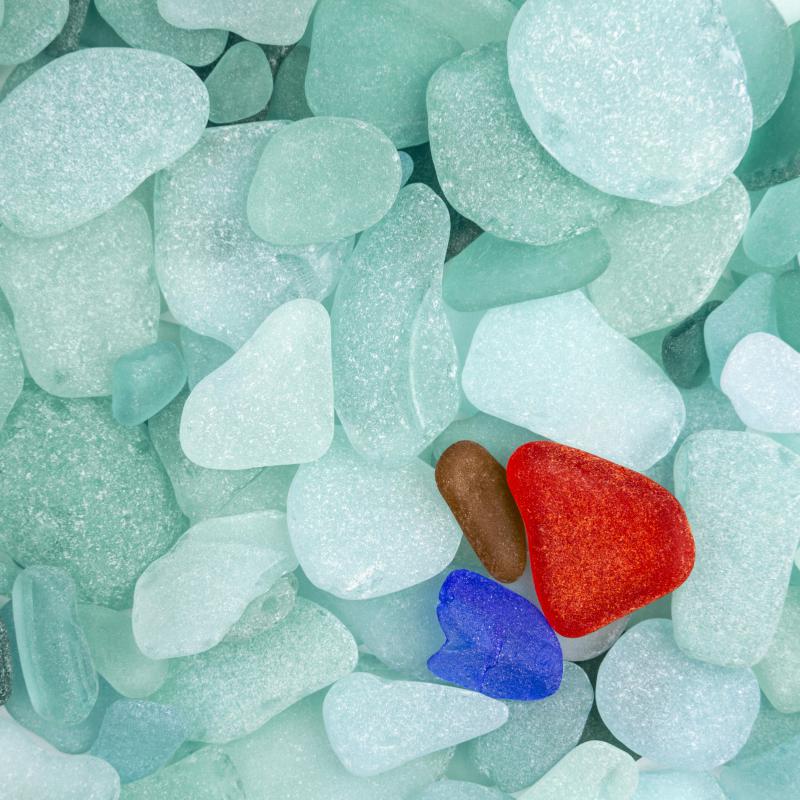At WiseGEEK, we're committed to delivering accurate, trustworthy information. Our expert-authored content is rigorously fact-checked and sourced from credible authorities. Discover how we uphold the highest standards in providing you with reliable knowledge.
What are Mermaid Tears?
Mermaid tears are small pieces of glass or plastic found in the world's oceans. When bottles, cups, or other debris are dropped or dumped into the water, they often break apart; the pieces are worn down by the tumbling of the waves and sand, eventually forming into smooth, rounded shapes. Many people collect sea glass — another name for glass mermaid tears — but the plastic type is considered quite dangerous to marine life. These tiny chunks of plastic may not look like much when held in the palm of the hand, but when one considers the fact that they are widely distributed in the oceans, they can seem a bit more ominous.
Sea Glass

There are several types of mermaid tears, depending on what material they are made of. The smooth, rounded, frosted tears that are formed from glass that has been worn down by the sea are often quite sought after; this sea glass, which can be found in many different colors, can be made into jewelry and other trinkets, or simply collected as a beautiful stone. Glass mermaid tears have become somewhat difficult to find in recent years, however, as more products are sold in plastic bottles instead of glass. Some people use artificial methods to create the tumbled look of sea glass, but many collectors consider this to be "craft glass" and not real sea glass.
Nurdles and Other Plastics

Two different types of plastic debris are also known as mermaid tears; the first is also known as a nurdle. Nurdles are very small pieces of plastic which are designed to be melted down and then molded or otherwise shaped to make plastic objects. They are widely used throughout the plastic industry. The most common source for nurdles is industrial spills from trucks and container ships; because nurdles are so small, they are hard to contain, and they slip away from containers and into waterways or into the ocean directly.

The other form of plastic mermaid tear is a small piece of plastic similar in size to a nurdle, caused by the wearing down of finished items. For example, if a broken plastic cup ends up in the ocean, the parts will slowly break up even further, turning into small plastic tears. Studies on the plastic debris in the ocean seem to suggest that these pieces only break down up to a certain point, and after that, they will float in the ocean for thousands or perhaps millions of years, potentially causing serious problems.
The Dangers of Mermaid Tears

All types of mermaid tears are forms of pollution, although glass debris is usually far less dangerous than plastic. One of the reasons that sea glass has become harder to find is that one of its sources — people on boats simply tossing bottles overboard when they are empty — is far less common than it once was. Glass is also commonly recycled, so less of it makes its way into landfills. Although still a pollutant, glass is also usually less dangerous to ocean animals, although they can be cut or injured on sharp pieces.

By some measurements, nearly 90% of floating ocean pollution is made of plastic, and plastic mermaid tears are a serious problem for a number of reasons. The first and most obvious is that they are ingested by marine animals, who cannot digest them; as a result, animals can sicken or die with large numbers of mermaid tears in their digestive tracts. Bigger organisms may consume this plastic when they eat smaller organisms, and the plastic then becomes widely distributed in the marine food chain.
Perhaps more insidiously, plastic debris can also contain chemical pollutants. In addition to the chemicals naturally present in plastic, these small pellets can also pick up other chemicals and contaminants, ranging from toxins to endocrine disruptors, and any organism that ingests them will suffer as a result. Plastic mermaid tears are essentially like tiny toxic sponges with a deadly payload, and in some cases the effects may not be noticed for several generations.
AS FEATURED ON:
AS FEATURED ON:















Discussion Comments
They make me cry too.
Nurdles...sound harmless, yet so insidious. I used to pick them up off the beach when I was little, back in the '60's, never knowing what they were or where they came from.
I think that if the human race is not obliterated by some bacteria or asteroid, we will surely commit suicide by killing our own Earth.
I did not now mermaids existed
lol
because they make mermaids cry!!
Sad to hear :(
I wonder why they call it "mermaid tears" ? :\
Post your comments